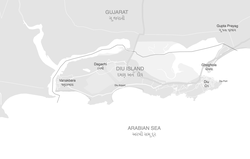Top Qs
Timeline
Chat
Perspective
Diu district
District in Dadra and Nagar Haveli and Daman and Diu, India From Wikipedia, the free encyclopedia
Remove ads
Diu district (/ˈdiːuː/) (formerly Distrito de Dio)[4] is one of the three districts of the union territory of Dadra and Nagar Haveli and Daman and Diu of India.[5] The district is made up of Diu Island and two small enclaves of Simbor and Gogola, at the border with the state of Gujarat. The district headquarters are at Diu Town. It is the ninth least populous district in the country (out of 640).[6]
Remove ads
History


The district was historically part of the Saurashtra region of Gujarat. Mirroring the system of administrative division in Portugal, Diu district (Distrito de Diu) was established as an administrative division of the Portuguese State of India (Estado da Índia) in the first half of the 19th century. It was headed by a district governor, subordinate to the governor-general of Portuguese India in Goa. The district included the single municipality of Diu, which was further subdivided into civil parishes.[7]
It remained an overseas territory of Portugal until it was annexed by Indian forces on 19 December 1961. From 1961 to 1987, it was a part of the union territory of Goa, Daman and Diu. In 1987, it became a part of the newly formed union territory of Daman and Diu. In January 2020, the district became part of the new union territory of Dadra and Nagar Haveli and Daman and Diu.[7]
Remove ads
Geography
Diu district occupies an area of 40 square kilometres (15 sq mi),[8]
It consists of Diu Island and a part on the mainland (the Ghogolá peninsula). 20 km East of Diu Island, is the small territory of Simbor.
Sub-districts
Diu Island
The town of Diu and most of the district's villages and settlements are on Diu Island. Many of these places have been renamed since the Invasion of 1961.
Ghogholá
The area on the mainland borders Gir Somnath district of Gujarat. It contains the village of Ghogholá. The village lies on the mainland opposite the eastern end of the island .
Simbor
The tiny territory of Simbor, located about 25 km east of the town of Diu, is also part of the district. It has no permanent population.
Demographics
According to the 2011 census Diu district has a population of 52,074,[6] roughly equal to the nation of Saint Kitts and Nevis.[9] This gives it a ranking of 631st in India (out of a total of 640).[6] The district has a population density of 1,301 inhabitants per square kilometre (3,370/sq mi) .[6] Its population growth rate over the decade 2001-2011 was 17.73%.[6] Diu has a sex ratio of 1030 females for every 1000 males,[6] and a literacy rate of 83.36%.[6]
There is a small community of the variety of Indo-Portuguese creole spoken in the region known as Daman and Diu Portuguese Creole.[10][11][12]
Remove ads
Sister cities
Diu Island is twinned with the city of Loures, in Portugal.[13]
Landmarks
Summarize
Perspective
Diu is home to a few surviving buildings and monuments with Portuguese architecture. The best preserved are the churches and fortifications.
The nearest railway junction is Veraval, which is 90 km from Diu. Major cities like Mumbai, Ahmedabad, Pune, Jabalpur (Madhya Pradesh), Dwarka and Thiruvananthapuram are directly connected to Veraval Railway Station. Delwada is 8 km from Diu.
Churches and chapels

1. Churches of St. Paul and St. Thomas (Diu)
2. Church of St. Francis of Assisi (Diu)
3. Church of Our Lady of Remedes (Fudam)
4. Church of Our Lady of Mercy (Vanakbara)
There has been a steady exodus of Christians from Diu[14] ever since the Invasion of 1961. This has led to many of their historic and historic and religious sites being victims of abandonment, disrepair, conversion to secular use or demolishment.
Fortresses
Due to constant invasions from neighboring kingdoms as well as distant powers, the Portuguese built several fortifications all over the district. Most survived to this day, although some have little to no physical traces of their existence.
Beaches
- Nagoá Beach, most visited beach in on Diu.
- Ghogolá Beach, largest beach off the island of Diu.
- Chakratirth Beach
- Barra Beach
- Nadia Caves
Gallery
- Diu Fort Fixed Cannons
- St. Thomas Church, Diu
- Diu fort
- Nadia Caves of Diu
- St. Paul's Church, Diu
- Church in Nani Daman Fort
- Se Cathedral
- View of Water Fort Prison from Diu Fort with watchtower of Diu Fort
- Portuguese Fort
- Diu shores in Monsoon
Remove ads
See also
References
External links
Wikiwand - on
Seamless Wikipedia browsing. On steroids.
Remove ads












